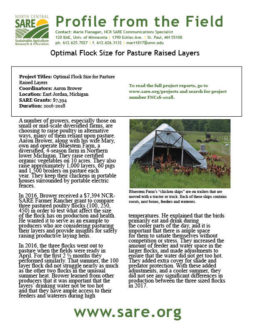A number of growers, especially those on small or mid-scale diversified farms, are choosing to raise poultry in alternative ways, many of them reliant upon pasture. Aaron Brower, along with his wife Mary, own and operate Bluestem Farm, a diversified, 4-season farm in Northern lower Michigan. They raise certified organic vegetables on 10 acres. They also raise approximately 1,000 layers, 60 pigs and 1,500 broilers on pasture each year. They keep their chickens in portable houses surrounded by portable electric fences.
In 2016, Brower received a $7,394 NCR-SARE Farmer Rancher grant to compare three pastured poultry flocks (100, 250, 450) in order to test what affect the size of the flock has on production and health. He wanted it to serve as an example to producers who are considering pasturing their layers and provide insights for safely raising productive laying hens.
In 2016, the three flocks went out to pasture when the fields were ready in April. For the first 2 ½ months they performed similarly. That summer, the 100 layer flock did not struggle nearly as much as the other two flocks in the unusual summer heat. Brower learned from other producers that it was important that the layers’ drinking water not be too hot and that they have ample access to their feeders and waterers during high temperatures. He explained that the birds primarily eat and drink during the cooler parts of the day, and it is important that there is ample space for them to satiate themselves without competition or stress. They increased the amount of feeder and waterer space in the larger flocks, and made adjustments to ensure that the water did not get too hot. They added extra cover for shade and predator protection. With these added adjustments, and a cooler summer, they did not see any significant differences in production between the three sized flocks in 2017.
“What is the optimal layer flock size? Is smaller better? My conclusion for the moment is that size does not matter,” reported Brower. “What matters is that every bird have ample space to eat and drink to reduce stress. There needs to be plenty of shade for every bird and protection from predation to the greatest extent possible.” That begs the question, why not confine them to a barn and give them everything they need for optimal performance?
“Our answer is that we place a great deal of value on raising chickens on pasture,” said Brower. “We want them to have a life out of doors with constant access to grass and sunshine as much of the year that our climate allows. Because of this, we open our birds up to a higher degree of predation and stress from the elements. It is our duty as stewards to minimize the dangers and stresses of predation and climate to the greatest degree possible within our systems.”
View Brower's presentation on this project, from the 2018 Farmer's Forum, through NCR-SARE's Youtube playlist. Visit www.youtube.com/NCRSAREvideo for this and other videos.
View Related SARE Grant:
- Optimal Flock Size for Pasture Raised Layers (FNC16-1028)
